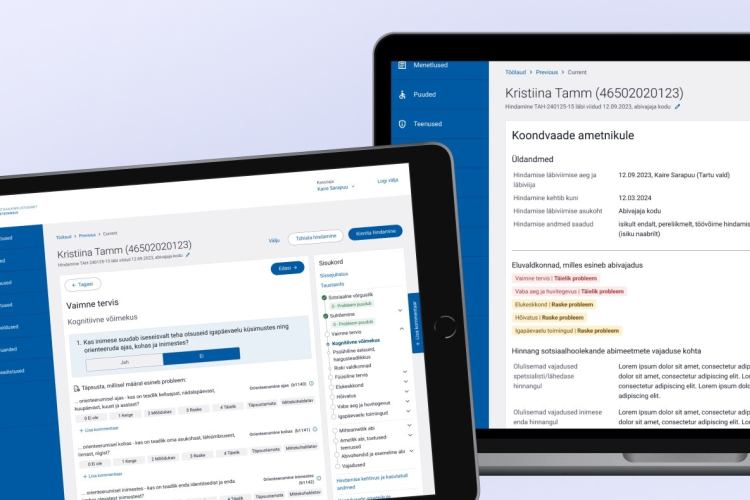How does relevant data-based reporting simplify the lives of entrepreneurs?
As citizens, we are accustomed to using fast and efficient e-country services to communicate with our country. Digital platforms do the heavy lifting for us whether we have to apply for various documents, submit our tax income returns, or use healthcare services.
But the digital communication between the state and entrepreneurs has not reached such state of harmony yet in every field. For entrepreneurs, reporting to the state can be a complicated and time-consuming process.
The challenges in exchanging information between the state and entrepreneurs
The same information must oftentimes be submitted to various different agencies – this wastes the entrepreneurs’ valuable time and resources, and burdens them with a much bigger administrative load. Besides, it is not always clear whether all the data that is collected from the entrepreneurs via the different mandatory reports is even necessary for the state and used in data analyses within a relevant time period.
That last point AKA using data gathered from reports within a relevant time period is a whole separate facet in the process. A lot of reports are submitted on a yearly basis, which means that a lot of data analyses are conducted using, on average, year old data. However, such data might not be particularly relevant in today’s fast-changing world.
Additionally, reports include a lot of assessments and explanations in free form writing that reflect the writer’s subjective opinions or provide them with the option of explaining things in a creative manner.
As a result, a lot of subjective data and hard to compare intel is collected and in turn, this affects the quality of the analyses conducted by the state. Data collected in this format cannot be used by different state agencies in any automated and machine-readable way.
In this blog post, we will discuss how the administrative load of entrepreneurs could be decreased, data quality increased, and data collection processes optimised to make reporting to the state more efficient and easier.
Data-based reporting – what is it?
On the Real Time Economy website, data-based reporting is defined as follows:
„Data-based reporting is a system of technical solutions where entrepreneurs do not have to report to state agencies and can instead use their accounting software to send out aggregated data.“
But, as often tends to happen with these kinds of things, data-based reporting already has multiple definitions, and all of them combined provide probably the best definition for this idea.
In the different related analysis projects that we have conducted, we have provided the following definitions:
„The purpose of data-based reporting is to provide a solution to submit data for obligatory reporting straight from the software, machine-to-machine. Unlike with classic form-based reporting, there is no need to fill out report forms.”
„Data-based reporting means that the company can submit the necessary data for obligatory reporting to the state straight from their own information system in a machine-readable format. Unlike with classic form-based reporting, there is no need to fill out report forms.“
In other words, it is a new and potential-filled method for fulfilling the reporting obligation of companies that is based on submitting the relevant data that is gathered for reporting through various business processes to the state via a machine-based interface.
On the Real Time Economy website, the benefits of this method are described as follows:
- more precise and reliable reporting;
- data straight from the source, which helps avoid mistakes made when filling out forms by hand;
- time and money saved;
- the capability to react to changes quickly and make data-based decisions.
Contact with data-based reporting and what that can bring about?
The Real Time Economy vision ambitiously states that the presumed deadline for switching over to data-based reporting is 2025.
An steering group has been formed for this that includes a large number of state agencies, from Statistics Estonia to the Ministry of Climate’s administrative bodies. From the private sector, various associations and accounting software developers have been brought into the steering group.
So though it may seem that the 2025 deadline is too optimistic from the perspective of most reports, data-based reporting is still an unavoidable future that will replace today’s dominant form-based reporting at one point. If this is true, then every entrepreneur will have to implement this method. But what does that mean? What must entrepreneurs take into account?
This first thing that can no longer be avoided is the digitisation of data. If obligatory reporting must be done automatically via a machine-based interface, then the entrepreneur must store all the relevant data in relevant software(s).
The second condition is that the entrepreneur must provide the relevant software(s) with an X-Road interface to the reporting environment that will be created by the state. And to ensure that the right data is transferred in the correct format, the entrepreneur must implement the unified taxonomy created by the state.
Hold up! Taxonomy? If you can recall your high school biology lessons, taxonomy is the classification of living organisms where each species has a designated spot in a complete classified system of wildlife. What does that have anything to do with data-based reporting?
In data-based reporting, taxonomy has been given a new definition that is based on certain similarities with the original definition. It is a system of classifiers that organises and classifies data. This creates a unified framework that helps to categorise and describe different data.
So we could also call the taxonomy a set of agreed-upon rules that helps to contextually unify data gathered from different data holders (e.g. by connecting information like how the attribute „salary” in the software used by one company and the attribute „income” in the software used by another company signify the same thing). Data that has been unified like this is easier to use, interpret, and analyse.
Developing such a taxonomy will require the state agencies to conduct an in-depth analysis to determine what kind of data they actually require and how it should be presented (e.g. what is the best unit for measuring a specific numeric value).
As a result, the number of attributes demanded from entrepreneurs for reporting will decrease. An example of this is when we conducted an analysis for the Ministry of Climate and identified that district heating companies have over 600 atrributes related to fuel in their obligatory reports.
Altogether, the calculations show that different state agencies request over 400 reports from companies and all those reports combined include over 60 000 data fields.
In conclusion, when data-based reporting is implemented, then entrepreneurs must double check their data management and, if necessary, sort it out and ensure that its in accordance with the unified taxonomy. Depending on the field and the company doing the reporting, the amount of changes that need to be made to the current data management will vary quite a bit.
From a general point of view, it can be said that the more separate calculations an entrepreneur has to do to fill out a report form today, instead of pulling the relevant values from their software and writing those down, the more work they will have to put in to reorganise their data management methods when switching over to data-based reporting.
At the end of the day, once data-based reporting has been implemented, it will enable entrepreneurs to save time and money on filling out forms and decrease their administrative load. And as an additional bonus, errors that stem from having to fill out the forms manually will become a thing of the past.
The benefits can also reach further. If data-based reporting ends up being much closer to real-time data than the current form-based reporting (as it is ideally meant to be) and state agencies are able to conduct more frequent data analyses, then we can achieve up-to-date decision making. And those decisions will be much more data-informed than they are today.
What to consider when switching over to data-based reporting?
The most important requirement is achieving technological maturity. This largely means two things for companies:
- ensuring that the data required for the reporting obligation is stored and managed in relevant software(s);
- ensuring that management and IT developments are standardised, documented, communicated, and that risks have been systematically managed and hedged.
The former means that machines cannot transfer data if it is stored on paper documents or physical folders. The latter guarantees that data management, developments made for its improvement, and the interface created for data-based reporting do not all become a so-called black box if the person responsible for all of it leaves the company or a contract with an external development partner expires.
Once the company has achieved technological maturity, then switching over to data-based reporting will mostly involve two big steps:
- implementing the unified taxonomy developed by the state in the company’s data management;
- interfacing with the state’s reporting environment via X-Road.
Implementing the taxonomy involves going over the current data management and making any necessary changes to it. The amount and nature of these changes will vary by field, but it may mean having to gather and manage more detailed data than before, adding in missing data, or even having to aggregate or transform data to fit a specific format.
To create the interface, the company must join X-Road, which includes having to implement a security server and verifying it by applying for different certificates (e.g. an authentication certificate, a signing certificate).
For data transfer, the state recommends using the XBRL GL (eXtensible Business Reporting Language Global Ledger) XML standard, which follows an accounting-based logic.
The Real Time Economy website also mentions transferring data from the company’s accounting software to the state agencies. Unfortunately, a number of the reports that fall under the scope of switching over to data-based reporting require more than just accounting data related to purchases and sales.
For example, in environmental reporting, entrepreneurs are mainly asked for completely different type of data – the amount of natural resources used, the amount of waste material that ends up in the environment etc, which do not involve any buyers, sellers or a transaction between them.
In these cases, the data required for the reports is not store in accounting software and even using XBRL GL can be very complicated, though based on the analyses we have conducted, it might be possible to achieve.
How can we help?
At Trinidad Wiseman, we have analysed the reporting obligations of two fields as well as how these fields could switch over to data-based reporting. We have direct contact with the taxonomy being developed in both fields and we have seen how different the technological capabilities of these fields are.
Regarding the taxonomy, we know from experience how it can seem very complex and hard to understand at first. Contextualising it requires time and concentration, and letting go of our current understanding of reporting being a framework that primarily relies on filling out report forms.
Switching over to data-based reporting is not merely an IT solution. It is a fundamental and conceptual change where we must adjust our view of reporting from the current form-based to now being data-based.
This means that instead of today’s report forms which are essentially fillable documents we have to start submitting data that various state agencies can then use as needed by, for example, doing different calculations based on that data.
In other words, all data created by companies through their work processes must be in the required format (this is determined by the taxonomy) and saved in relevant software(s) or information systems.
With data-based reporting, it will no longer be possible to just sit down behind a computer once the reporting deadline draws near, open up the report form and start filling it out by trying to derive or calculate the required values if there is no data stored about them during the work processes.
For data-based reporting, all those values must be created during the work processes so that they could be automatically submitted at a pre-determined time.
Switching over to data-based reporting required the entrepreneur to organise their data management to a smaller or bigger degree, and to ensure all of it works in accordance with the newly developed taxonomy. This is where Trinidad Wiseman can help you.
We can analyse and evaluate your company’s technological maturity, compare the correspondence of your current data management to your field’s taxonomy, and help you find solutions for improving your data gathering and management processes. Get in touch with us and let us discuss your options and find the most suitable solution for you.
Conclusion
The state is preparing for the implementation of data-based reporting. Different fields are already working on making systematic preparations to figure out how and in what way they could implement data-based reporting.
Concurrently, the taxonomies for all the different fields are being developed. All of this refers to one thing – data-based reporting will become a reality at one point.
For companies, data-based reporting means having to make investments into organising their data management and creating an X-Road interface with the state’s reporting environment. But if a company has yet to fully digitise their data management and/or their management and IT developments are not yet systematically organised, then the entrepreneur must first put effort into ensuring the technological maturity required for switching over to data-based reporting.
In conclusion, data-based reporting saves the company’s time and money when fulfilling their reporting obligations and provides the company with a sense of security by ensuring that no man-made errors end up in the reports. The time and money saved can instead be directed towards the development of the company’s products or services.
We have also written about proactive services from the point of view of a private individual. Read our earlier posts: “What prerequisites must be met for the development of proactive e-services?” and “Proactive event-based services, i.e., the next step in the Estonian digital transformation”.








